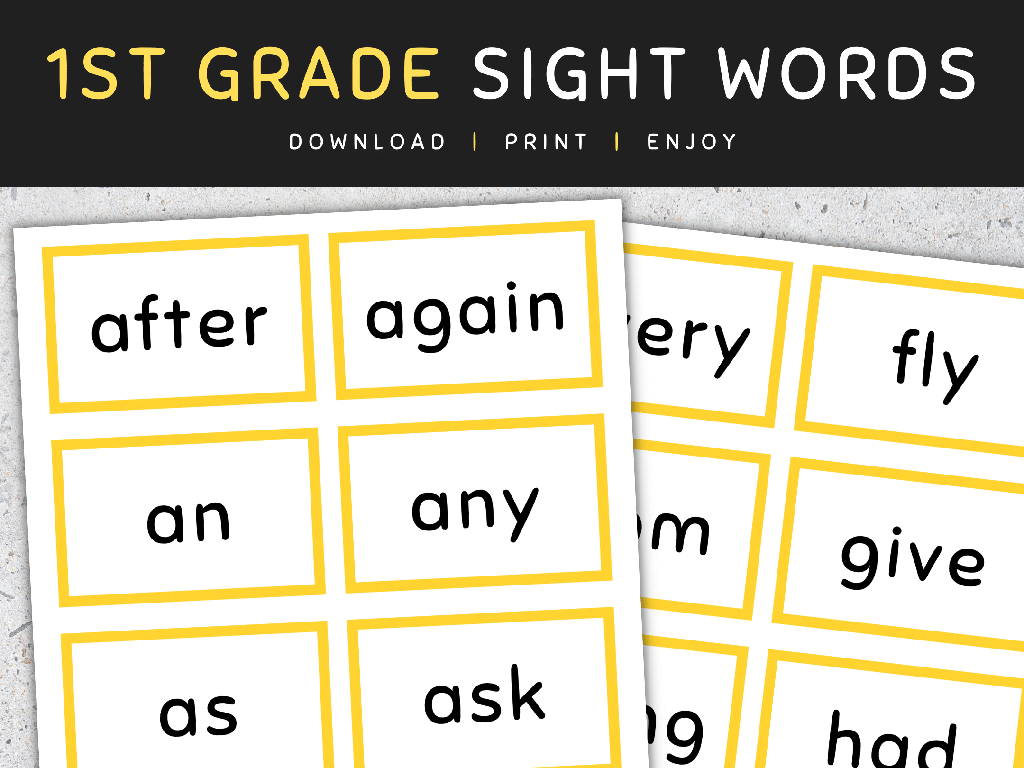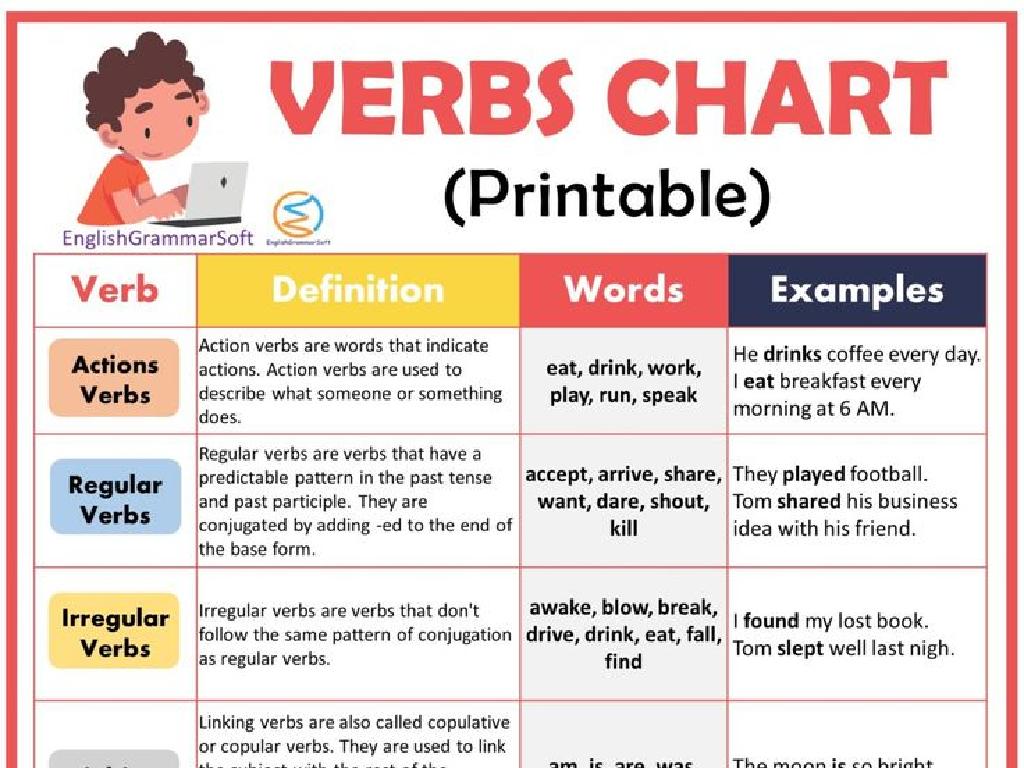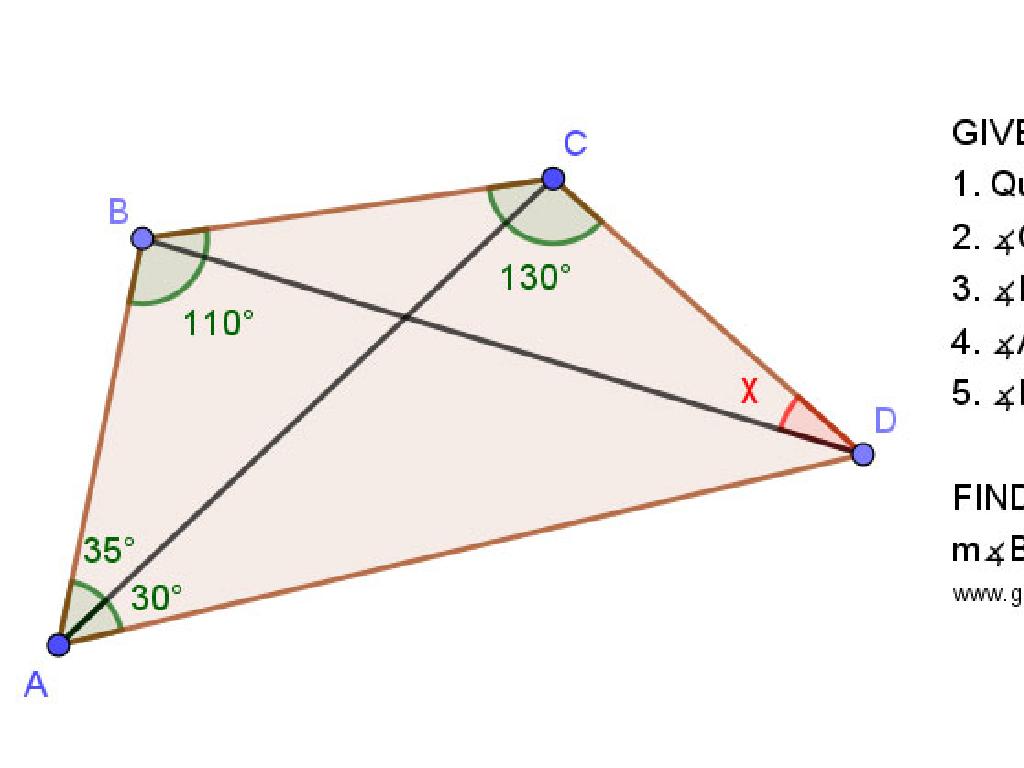Estimate To Compare Quotients
Subject: Math
Grade: Fourth grade
Topic: Divide By One-Digit Numbers
Please LOG IN to download the presentation. Access is available to registered users only.
View More Content
Estimating to Compare Quotients
– What is estimation?
– Estimation is finding a number close to the exact amount.
– Estimation’s role in division
– Estimation simplifies division by rounding numbers.
– Comparing quotients using estimation
– Use estimation to determine which quotient is larger or smaller.
– Practice estimation with examples
– Example: 250 ÷ 5 H? Compare with 300 ÷ 4 H?
|
This slide introduces the concept of estimation, a crucial skill in mathematics that allows students to find approximate answers without calculating the exact numbers. Estimation is particularly useful in division when exact numbers are not needed, or to check the reasonableness of an answer. Teach students how to round numbers to the nearest ten or hundred to make division easier. Then, show them how to use these estimates to compare the size of different quotients. Provide practice examples and encourage students to explain their thinking process. This will help them understand the practical applications of estimation in everyday math problems.
Understanding Estimation in Division
– What is estimation?
– Estimation is making a smart guess about numbers
– Why we use estimation
– To solve math problems faster and with ease
– Estimation in daily life
– Guessing the total cost of groceries or time needed for a trip
– Estimation makes division easy
– Estimating quotients helps compare numbers quickly
|
This slide introduces the concept of estimation, which is a fundamental skill in mathematics, especially useful in division. Estimation allows students to make reasonable guesses about numbers, which can be particularly helpful when exact values are not needed, or when quick calculations are required. It’s important to provide real-life contexts where estimation is applicable, such as totaling the cost of items while shopping or determining the time it might take to travel somewhere. Emphasize that estimation is not about finding the precise answer but about getting close enough to make an informed decision or comparison. Encourage students to practice by estimating outcomes in various scenarios and comparing their estimates to actual results to see how close they were.
Estimating to Compare Quotients
– Reviewing division basics
– Division is splitting into equal parts or groups
– Understanding one-digit divisors
– One-digit divisors are numbers 1-9 used to divide
– Applying division in real life
– Example: Sharing 8 apples with 4 friends
– Estimating to compare results
– Use rounding to estimate the size of quotients
|
Begin with a quick review of division, ensuring students recall that division is the process of splitting a number into equal parts. Emphasize the role of one-digit divisors and how they are used in division. Provide real-life scenarios, such as dividing items among a group of friends, to illustrate the concept. Teach students how to estimate quotients by rounding numbers before dividing, which helps compare the size of results quickly. This skill is useful for checking work and understanding division in everyday situations. Encourage students to practice with different numbers and to share their methods of estimation.
Estimating Quotients
– Understanding quotients
– A quotient is the result of division
– Rounding numbers to estimate
– Round to the nearest ten or hundred to simplify
– Group estimation practice
– Let’s solve estimation problems as a class
– Applying estimation skills
– Use estimation to check division answers
|
This slide introduces the concept of estimating quotients as a way to quickly assess the result of division without calculating the exact answer. Begin by explaining that a quotient is the answer we get when we divide one number by another. Teach students how to round numbers to the nearest ten or hundred to make estimation easier. Engage the class with a group activity where everyone practices estimating quotients together. Emphasize the importance of estimation as a tool to verify the reasonableness of their division answers. Provide several examples and encourage students to explain their thought process during the activity.
Comparing Quotients Using Estimation
– Understanding quotient comparison
– Estimation techniques for quotients
– Round numbers to nearest ten or hundred to estimate
– Example: 250 ÷ 5 vs. 180 ÷ 3
– 250 ÷ 5 H 50 and 180 ÷ 3 H 60, so 180 ÷ 3 is larger
– Determining the larger quotient
– Use estimation to quickly compare without exact division
|
This slide introduces the concept of comparing quotients through estimation, a key skill in understanding division. Start by explaining why it’s useful to compare quotients: it helps in making quick decisions and understanding relative sizes without precise calculations. Teach students to round numbers to the nearest ten or hundred to make estimation easier. For example, compare 250 ÷ 5 and 180 ÷ 3 by estimating the quotients: 250 rounds to 250 (since it’s already a multiple of 5) and 180 rounds to 180 (a multiple of 3), making the division straightforward. Students will see that 180 ÷ 3 gives a larger number than 250 ÷ 5. Encourage students to practice with different numbers and to explain their reasoning during the process.
Let’s Practice Estimating Quotients!
– Solve Practice Problem 1
– Estimate before solving: 250 ÷ 5 H ?
– Tackle Practice Problem 2
– Estimate 480 ÷ 6 and compare with Problem 1
– Determine the greater quotient
– Is 250 ÷ 5 greater than 480 ÷ 6?
– Discuss your solutions in class
|
This slide is designed for an interactive class activity where students will practice estimating quotients to compare sizes. For Problem 1, guide students to round the dividend or divisor to the nearest ten or hundred to make mental math easier. For Problem 2, students should use their estimation skills to determine which quotient is greater without calculating the exact answer. Encourage students to share their estimation strategies and discuss the different approaches. This will help them understand the concept of estimation and its practical applications in comparing numbers. Provide additional examples if time allows and ensure that each student participates in the discussion.
Class Activity: Estimation Relay
– Form teams for relay
– Solve team estimation problems
– Use rounding to estimate quotients
– First team to finish wins
– Check each other’s work for accuracy
– Discuss winning strategies
– Share what worked best for your team
|
This activity is designed to make learning about estimation interactive and fun. Divide the class into small teams, ensuring a mix of abilities in each group. Each team will work together to solve a series of estimation problems by rounding numbers to the nearest ten or hundred to simplify division. Emphasize the importance of teamwork and checking each other’s work. The first team to complete their problems correctly wins a small prize. After the activity, discuss as a class what strategies were successful. Possible variations of the activity could include a timed challenge, relays with different estimation techniques, or a ‘beat the clock’ format where each team tries to improve their own time with successive rounds.
Estimation Reflections and Applications
– Summarize today’s estimation lessons
– We learned how to estimate quotients to compare sizes quickly.
– Applying estimation in daily life
– Estimation helps in making quick decisions, like shopping or cooking.
– Reflect on today’s learning enjoyment
– Share your favorite part of today’s class.
– Encourage home practice of estimation
|
As we wrap up today’s lesson on estimation, encourage students to reflect on what they’ve learned about estimating to compare quotients. Discuss how estimation is a valuable skill in everyday life, such as when shopping to quickly decide which product is a better deal, or in the kitchen to estimate how much of an ingredient is needed. Ask students to share what they enjoyed most about the lesson to reinforce positive learning experiences. Finally, suggest that students practice estimation at home, perhaps while helping with groceries or during other activities, to further solidify their understanding.






